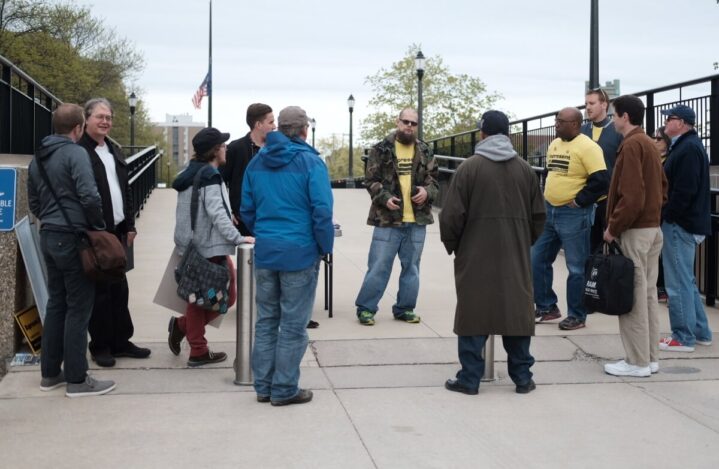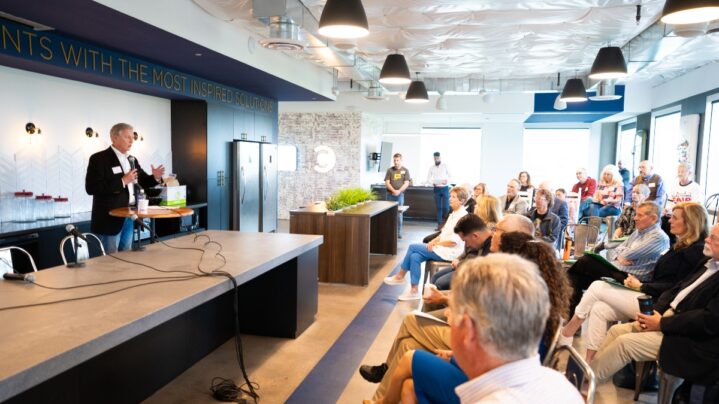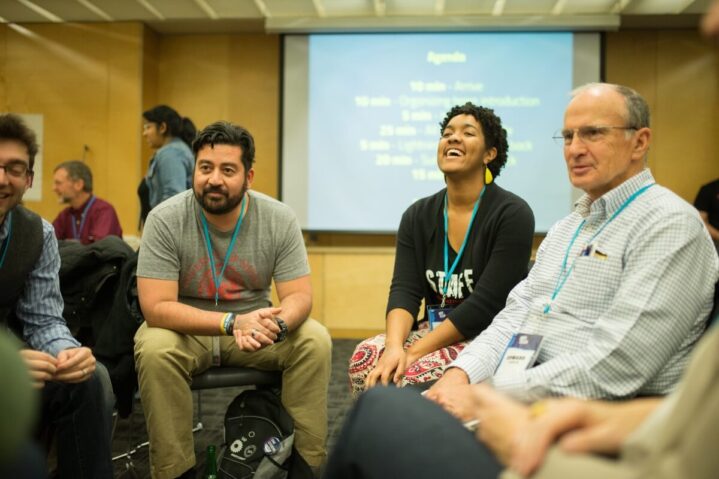How to Take Effective Political Action
How to Host an Event
What is a political advocacy event?
Political advocacy events are ones in which people gather together to learn or to take action. Some examples include trainings, information sessions, canvasses, phonebanks, textbanks, letters to the editor writing parties and more.

Why host one?
A great event can help your campaign in a number of ways, from gaining press attention, to getting new volunteer signups, to gaining respect and recognition in your community. In order to make your event as effective as possible, follow these guidelines. You’ll need to set measurable and achievable goals, plan and set an agenda, and publicize your event.
Steps to host a successful event
1. Determine measurable and achievable goals and objectives as well as tone and message
- Goal: How does this event help you achieve your campaign or advocacy goals?
- Objectives: What are the discrete, measurable objectives of the event? (Examples: Number of attendees, how many volunteers signed up at the event, how many press hits, etc.)
- Tone: Be thoughtful about the tone as that can impact results (Example: optimistic and purposeful)
- Message: What are the 1-3 talking points for the event?
2. Prepare your budget
- Do you know how much you’ll pay for a photographer? Videographer? Permits? Materials?
- Download our checklist to help you plan
3. Recruit your event team
You may want to identify people that can take on specific roles. Here are some suggested ones:
- Logistics Champion – this person is in charge of the behind-the-scenes coordination that makes every organization thrive. This includes reserving spaces, printing materials, confirming speakers, and any other support that solidifies the event.
- Outreach Hero – this person makes sure people show up by making confirmation and flake calls (calls to people who were expected to attend but did not show up).
- Media Chair – this person coordinates with local media outlets to spread the word. Duties range from writing letters to the editors, opinion pieces, sending press releases, and recruiting and coordinating with the photographer and/or videographer.
- Social Media Coordinator – this person manages your group’s social media accounts, including Webpage, Facebook, Threads, Instagram, or whatever platform you use.
- Trainer Coordinator – this person is in charge of the training program including material development, recruiting trainers, and organizing a training of the trainers to ensure an effective program.

4. Set agenda and write run of show
- Agenda: Determine what will happen at the event
- Run of Show: Create a timeline of what is going to happen when
5. Determine task list
Here are some key tasks you’ll probably need to assign while planning an event. This is not an exhaustive list as there might be other tasks that need to be done:
- Event coordination and management
- Set up an event page where people can learn the details and RSVP
- Create an invitation
- Reserve a space
- Design and print materials
- Identify and confirm speakers
- Outreach in the community
- Event recruitment
- RSVP confirms
- Engaging current supporters
- Draft a press release and coordinate with media outlets
- Manage social media platforms to help spread the word
- Coordinate food and drinks
- Determine if transportation or child care services are needed
6. Meet with the team
- Share the goals for the event
- Share the agenda and timeline with all participants/team members and get their input and feedback
- Coordinate with the team to assign roles and tasks to the members
- It’s important to make sure that tasks are distributed among the entire team.
7. Prepare and Hold Training (if necessary)
Make sure that everyone who is supporting the event understands the goals, objectives and tactics used at the event. Training may require materials like presentation materials, curriculum and other resources. Activities could include practicing speaking parts, reviewing run of show and role-playing to get everyone ready.

8. Find and attract attendees
- Message: Prepare a message for your invitation. It should be short and readable by clearly laying out when and where the event is, who is involved, what it is and why they should come.
- Audience: The more people you reach out to, the better. Ask former attendees and team members to reach out to their own circles, reach out to local groups (political or nonpolitical) and people who would be most impacted by the event.
- Messenger: Who is the message coming from? Try to use familiar voices within the community to make a personal connection.
- The Rule of Halves: If 100 are invited, 50 will say yes, 25 show up, 12 stay until the end, and 6 show up to the next meeting. Utilize the Rule of Halves to set your target number of invitations to distribute to meet your turn out goal..
9. Use effective recruitment tactics
- Personalized outreach such making phone calls or meeting with folks 1:1 to make the ask or while petitioning, tabling, talking with friends or neighbors
- Put up flyers
- Go to other organization meetings to invite people such as student clubs, community association gatherings, and political events
- Reach out to partner organizations and coalition partners and ask them to share the invitation with their community
- Social media promotion
- Email is a great go-to, especially a personal one asking them to RSVP, to ensure that you get a commitment from them. While not everyone who receives your email will read or open it, it’s still a great way to reach a large number of people.
- Follow up with each individual yes with a personalized email reminder up to one week before the event to confirm their attendance and then a follow up phone call up to 2 days prior to the event
- As folks show up, make sure they can sign-in so that you can collect their contact information.
- With this, you can follow-up with them to engage them in the future.
10. Create an outreach plan/timeline (include dates):
- Create online registration page
- Create facebook event recognize that people who reply to Facebook may not also RSVP on the event page, make sure they receive a follow up confirmation as well
- Email member/supporter list
- Phonebank invite people
- Textbank invite people
- Phonebank to turn people out
- Email/text message reminder
11. Prepare Media Plan (if necessary)
If you have a Media Coordination, they can:
- Identify and prepare spokespeople
- Write or assign someone to write a press release
- Send press releases to media outlets
12. Follow-Up After the Event
Make sure to reach out to everyone within 72 hours of the event to thank them for attending, while it is still fresh in their minds, and invite them to attend your upcoming meeting or event.
When you hold your meeting, it is likely that a smaller number of people who attended the event will turn out. We have found that having a meeting two weeks after the event is a great way to retain those who are interested in engaging with your group.
Event Planning Checklist
Eight Weeks Out
❏ Determine a good date & time for the event; make sure it doesn’t conflict with other community or partner events
❏ Book the event location
Six Weeks Out
❏ Find funding for food & refreshments
Four Weeks Out
❏ Create an invitation describing the event
❏ Utilize Facebook, email and social media to advertise the event
❏ List the event on community group calendars, newsletters and email lists
❏ Send an event description and email invitation to partners to share with their lists
Two Weeks Out
❏ Monitor registration and determine if the registration numbers are meeting your recruitment goal
❏ Ask other community groups and your coalition partners to help promote the event
❏ Flyering around town where likely supporters gather, such as libraries, coffee shops, and event announcement boards.
One Week Out
❏ Make announcements at local civic group meetings
❏ Phonebank the registration list to confirm people’s attendance and participation
❏ Send out email blast to those who are registered to encourage their participation
❏ Prepare event materials (reserve projector, etc)
Day Of
❏ Pick up food and refreshments
❏ Arrive early to set up
❏ Track attendance with sign-in sheet (an electronic sign in sheet can help move along the process)
❏ Take lots of pictures!
Day After
❏ Send thank you emails to speakers and/or staff who helped
❏ Plan your next meeting
❏ Reflect and debrief the effectiveness of the event with your team
❏ Identify participants that stood out for leadership recruitment
❏ Send thank you emails to the participants include resources and a specific ask
Helpful Hints
- Use radical hospitality
- Use the event as an opportunity to make personal connections with the attendees
- Use the event to help recruit others
- Try to make the event memorable
- Make sure that the event is accessible so that people know of the event, can find it and is ADA compliant
- Practice your run-of-show with the team, make sure that people know their role and responsibilities and talking points
- Involve new recruits – everyone likes to see a fresh face join the community, so do your best to get new volunteers out and activated
- Leadership development – use each event as an opportunity to delegate responsibilities and create new leaders.
- Include visuals, if at all possible
- Take photos/videos
- HAVE FUN!
